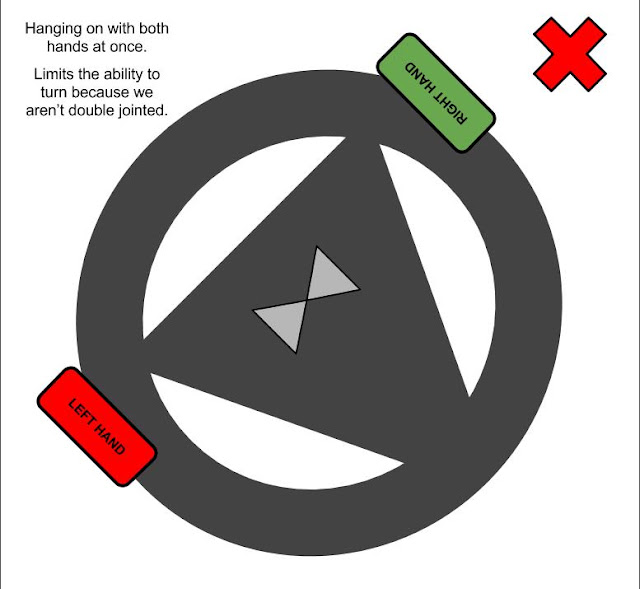Steering is a vital part of learning to drive, and many people rush it or use bad techniques.
In this post I briefly look at the two most common bad techniques, why they're bad and what causes them.
Learners are not as experienced, they are just beginning and not as skilled or use to driving. Everything is harder for them to start with, and easier to get wrong. I've seen several learners struggling to use the incorrect techniques they were taught. Steering should be easy after just a few hours of driving at most, not a struggle.
Starting properly is also important, why learn the incorrect foundations? We don't learn to read and write incorrectly at school, we learn to spell properly and correct foundations like the alphabet. So why not apply the same ideas and start learning to drive correctly?
It's hard to break these bad habits later once learnt. Steering is the same skill set as walking, learning a bad habit early makes it hard to relearn and fix later.
Below is an example of someone turning left using the 'hanging on' method.
This is an issue as we aren't double jointed, the top elbow lock ups and means the learner is unable to turn the wheel more if needed. Resulting in turning issues, like swinging out on turns.
To avoid this remember to let go, only one hand needs to grip the wheel at a time when turning.
Below is an example of someone turning left using the 'both hands on the same side' method.
The issue is it results in sudden and imprecise steering. With both hands on one side at once the driver cannot make accurate or smaller adjustments to the wheel. Instead they have to move back or forth in jerky and large motions.
A great way to see this is on exiting corners, if when exiting the driver is uneven and throws the weight from side to side. Then they're most likely getting both hands on the same side.
To avoid this keep the hands on opposite sides of the wheel. Pretend they're like magnets, repelling each other when too close.
I really can't stress this enough, but learning to avoid these mistakes early through lessons can save so much difficulty and money later. I've found the earlier students get lessons the less total lessons they need.
In this post I briefly look at the two most common bad techniques, why they're bad and what causes them.
Bad Habits
Over time we all develop bad habits and techniques when driving. But avoid passing these along to learners. Many instructing learners don't see the issue with teaching bad steering, they use these techniques all the time without any issues, so it must be fine.Learners are not as experienced, they are just beginning and not as skilled or use to driving. Everything is harder for them to start with, and easier to get wrong. I've seen several learners struggling to use the incorrect techniques they were taught. Steering should be easy after just a few hours of driving at most, not a struggle.
Starting properly is also important, why learn the incorrect foundations? We don't learn to read and write incorrectly at school, we learn to spell properly and correct foundations like the alphabet. So why not apply the same ideas and start learning to drive correctly?
It's hard to break these bad habits later once learnt. Steering is the same skill set as walking, learning a bad habit early makes it hard to relearn and fix later.
Hanging On
This is a common mistake for beginners, they hold on with both hands at once. They're told to hang onto the wheel and take it literally, or they're nervous and scared to let go, or a bit of both. Either way, they grip the wheel with both hands at once and end up with the hands on opposite sides. One at the top and one at the bottom.Below is an example of someone turning left using the 'hanging on' method.
This is an issue as we aren't double jointed, the top elbow lock ups and means the learner is unable to turn the wheel more if needed. Resulting in turning issues, like swinging out on turns.
To avoid this remember to let go, only one hand needs to grip the wheel at a time when turning.
Both Hands on the Same Side
This is another common mistake with steering, people get lazy and bring both hands to the same side of the wheel when turning. It's seen as easy and simple, so people (drivers and students) use it to cut corners and save on effort.Below is an example of someone turning left using the 'both hands on the same side' method.
The issue is it results in sudden and imprecise steering. With both hands on one side at once the driver cannot make accurate or smaller adjustments to the wheel. Instead they have to move back or forth in jerky and large motions.
A great way to see this is on exiting corners, if when exiting the driver is uneven and throws the weight from side to side. Then they're most likely getting both hands on the same side.
To avoid this keep the hands on opposite sides of the wheel. Pretend they're like magnets, repelling each other when too close.
Get Lessons if Struggling
If there's issues with steering the best way to fix it is lessons with a competent driving instructor. We all develop bad habits as drivers, it's hard for a non-professional not to pass these along.I really can't stress this enough, but learning to avoid these mistakes early through lessons can save so much difficulty and money later. I've found the earlier students get lessons the less total lessons they need.

